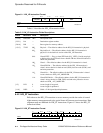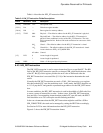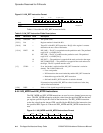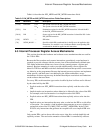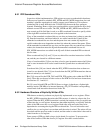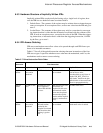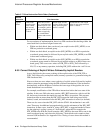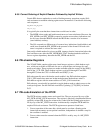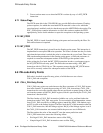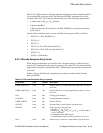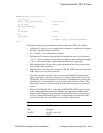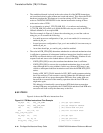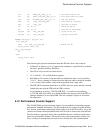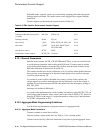6–12 Privileged Architecture Library Code
21264/EV68A Hardware Reference Manual
PALcode Entry Points
3. Correct actions must occur when the FPCR is written by way of a MT_FPCR
instruction.
6.7.1 Status Flags
The FPCR status bits in the 21264/EV68A are set with PALcode assistance. Floating-
point exceptions, for which the associated FPCR status bit is clear or for which the
associated trap is enabled, result in a hardware trap to the ARITH PALcode routine. The
EXC_SUM register contains information to allow this routine to update the FPCR
appropriately, and to decide whether to report the exception to the operating system.
6.7.2 MF_FPCR
The MF_FPCR is issued from the floating-point queue and executed by the Fbox. No
PALcode assistance is required.
6.7.3 MT_FPCR
The MT_FPCR instruction is issued from the floating-point queue. This instruction is
implemented as an explicit IPR write operation. The value is written into the first latch,
and when the instruction is retired, the value is written into the second latch. There is no
IPR scoreboarding mechanism in the floating-point queue, so PALcode assistance is
required to ensure that subsequent readers of the FPCR get the updated value.
After writing the first latch, the MT_FPCR instruction invokes a synchronous trap to
the MT_FPCR PALcode entry point. The PALcode can return using a HW_RET
instruction with its STALL bit set. This sequence ensures that the MT_FPCR instruc-
tion will be correctly ordered for subsequent readers of the FPCR.
6.8 PALcode Entry Points
PALcode is invoked at specific entry points, of which there are two classes:
CALL_PAL and exceptions.
6.8.1 CALL_PAL Entry Points
CALL_PAL entry points are used whenever the Ibox encounters a CALL_PAL instruc-
tion in the Istream. To speed the processing of CALL_PAL instructions, CALL_PAL
instructions do not invoke pipeline aborts but are processed as normal jumps to the off-
set from the contents of the PAL_BASE register, which is specified by the CALL_PAL
instruction’s function field.
The Ibox fetches a CALL_PAL instruction, bubbles one cycle, and then fetches the
instructions at the CALL_PAL entry point. For convenience of implementation, returns
from CALL_PAL are aided by a linkage register (much like JSRs). PALshadow regis-
ter R23 is used as the linkage register. The Ibox loads the PC of the instruction after the
CALL_PAL instruction, into the linkage register. Bit [0] of the linkage register is set if
the CALL_PAL instruction was executed while the processor was in PALmode.
The Ibox pushes the value of the return PC onto the return prediction stack.
CALL_PAL instructions start at the following offsets:
• Privileged CALL_PAL instructions start at offset 2000
16
.
• Nonprivileged CALL_PAL instructions start at offset 3000
16
.



